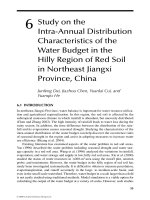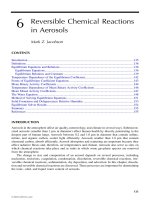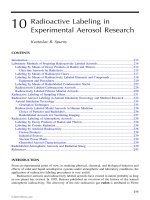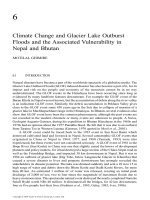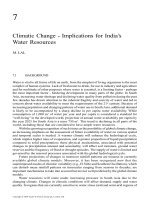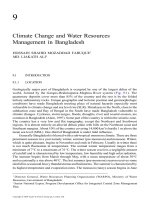INTERFACIAL APPLICATIONS IN ENVIRONMENTAL ENGINEERING - CHAPTER 6 docx
Bạn đang xem bản rút gọn của tài liệu. Xem và tải ngay bản đầy đủ của tài liệu tại đây (255.53 KB, 17 trang )
6
Removal of Heavy Metals from
Aqueous Media by Ion Exchange
with Y Zeolites
MARK A. KEANE University of Kentucky, Lexington, Kentucky, U.S.A.
I. BACKGROUND: POLLUTION BY HEAVY METALS
Heavy metals (HM) is a general collective term applied to the group of metals
and metalloids with an atomic density greater than 6 g cm
Ϫ3
and includes such
elements as Cu, Cd, Hg, Ni, Pb, Zn, Co, Al, and Fe [1,2]. The pollution and
toxicity associated with heavy metals is now well established, with mounting
evidence of adverse ecological and public health impacts [3,4]. The presence of
heavy metals in water has an appreciable effect on acidity [5], and the resultant
decrease in pH is known to adversely affect fish stocks and vegetation [6]. These
pollutants reach the environment from a vast array of anthropogenic sources as
well as natural geochemical processes. Heavy metal ions in solution are toxic to
humans if the concentration is sufficiently high, and Health Agency guidelines
set maximum acceptable HM concentrations in drinking water that are typically
less than 3 mg dm
Ϫ3
[7,8].
This chapter focuses on Fe, Co, Ni, Cu, Cd, and Pb as six representative HM
pollutants. Iron is found naturally in large concentrations in soil and rock, nor-
mally in an insoluble form, but it can, as a result of a series of naturally occurring
complex reactions, be converted to soluble forms that often result in water con-
tamination [7]. Excess iron in groundwater can also arise from the use of iron
salts as coagulants during water treatment or as a byproduct of pipe corrosion
[1]. Iron is very unlikely to cause a threat to health at the concentrations typically
recorded in water supplies, but excessive amounts can certainly have detrimental
effects. The presence of cobalt as a water pollutant can be due to a leaching
from rock/soil or the result of commercial activities relating to agriculture or the
mining/metallurgical/electronics industries or as a byproduct of electroplating
and pigment/paint production [6,9]. Nickel and copper are among the most toxic
TM
Copyright n 2003 by Marcel Dekker, Inc. All Rights Reserved.
94 Keane
metals for both higher plants and many microorganisms [10,11], while copper,
along with arsenic and mercury, is recognized as exhibiting the highest relative
mammalian toxicity [4]. Sources of nickel and copper pollutants include mining/
smelting, agricultural materials, the electronics, chemical, and metallurgical in-
dustries, as well as waste disposal in the form of leachates from landfills [6,12–
14]. Cadmium is classed as a highly toxic nonessential metal that affects the
action of enzymes and impedes respiration, photosynthesis, transpiration, and
chlorosis [6,10]. On a comparative basis, lead is neither as toxic nor as bioavaila-
ble as cadmium but is more ubiquitous in the environment and acts as a cumula-
tive toxin [6,15]. Sources of both cadmium and lead pollution include mining,
agriculture, fossil fuel combustion, the metallurgical and electronic industries,
and the manufacture and disposal of batteries, paints/pigments, polymers, and
printing materials [3,6,13,16].
II. STRATEGIES FOR HEAVY METAL POLLUTION
REMEDIATION
The most commonly employed treatment method for HM removal is chemical
precipitation [1,17]. Although this approach is relatively simple and inexpensive,
it has the decided drawback of generating a large volume of “sludge” for disposal.
Iron, for instance, is soluble in the ferrous state, Fe(II), but is oxidized to the
insoluble ferric form, Fe(III), in air [18], and the ferric iron hydrolyzes readily
to form insoluble ferric hydroxide. Conventional water treatment for the removal
of iron involves the oxidation of ferrous iron and removal of ferric hydroxide by
sedimentation and filtration [18,19]. Alternative HM recovery methods include
electrowinning, reverse osmosis, electrodialysis, solvent extraction, evaporation,
ion exchange, and biological treatment [20,21]. The process of ion exchange, the
focus of this article chapter, involves the replacement of toxic metal ions in solu-
tion by the more benign counterions that balance the surface charge of the solid
exchanger. Ion exchange with aluminosilicate zeolites in batch or continuous
operation, when compared with chemical precipitation (as the best established
methodology), has the decided advantage of minimal associated waste generation,
process simplicity, and ease of maintenance. Zeolites have been applied as ion
exchangers in the removal of ammonium ions from municipal wastewater, in
water softening, and, to a limited extent, in the treatment of radioactive water
containing cesium and strontium [22]. However, the application of zeolites to
environmental pollution control in terms of heavy metal removal from aqueous
media has received scant attention.
III. APPLICATION OF ZEOLITE ION EXCHANGERS
Zeolites are crystalline aluminosilicates that are structurally unique in having
cavities or pores with molecular dimensions as part of their crystalline structure.
TM
Copyright n 2003 by Marcel Dekker, Inc. All Rights Reserved.
HM Removal via Y Zeolite Ion Exchange 95
Zeolites possess “compensating,” or charge-balancing, cations (typically Na
ϩ
)
that counterbalance the negative charge localized on the aluminosilicate frame-
work, where the exchange capacity is governed by the Si/Al ratio. Because these
ions are not rigidly fixed at specific locations within the hydrated unit cell, it is
possible to effect exchange with external cations in solution [23]. Both synthetic
[2,24–32] and naturally occurring [22,24,33–35] zeolites have been used success-
fully to exchange the indigenous Na
ϩ
ions with heavy metals in aqueous solution.
The application of the high-surface-area zeolite Y to the removal of Cu, Ni, Cd,
and Pb from water has been reported previously [2,32]. While the process of ion
exchange with zeolites has been the subject of a number of investigations, the
emphasis has invariably been placed firmly on the synthesis of efficient zeolite-
based catalysts [36–38]. The dearth of literature on the use of zeolites for heavy
metal cleanup is possibly due to the low solution pH that is often necessary
(particularly in the case of iron) to prevent metal hydroxide precipitation and
ensure that ion exchange is stoichiometric; zeolites can suffer structural break-
down even under weakly acid conditions [21,28]. Hlavay et al. [39] have, how-
ever, investigated the efficiency of the zeolite clinoptilolite for the removal of
iron from drinking water and found that the operation of three ion exchange
columns in series reduced the initial iron content (in the range 0.7–0.9 mg dm
Ϫ3
)
to below detectable levels. The action of natural zeolite clays in lowering lead
toxicity in freshwater fish [40], limiting cadmium and lead leaching in soil [41–
43], and removing HM from wastewater [44–52] has received some coverage in
the open literature.
IV. EXPERIMENTAL CONSIDERATIONS
The parent zeolite was Linde molecular sieve LZ-52Y, which has the nominal
anhydrous unit cell composition Na
58
(AlO
2
)
58
(SiO
2
)
134
: density ϭ 1.9 g cm
Ϫ3
;
free aperture (anhydrous) ϭ 0.74 nm; unit cell volume ϭ 0.15 nm
3
; void vol-
ume ϭ ca. 50%. In order to obtain, as far as possible, the monoionic sodium
form, the zeolite as received was contacted five times with 1 mol dm
Ϫ3
aqueous
solutions of NaNO
3
. The zeolite was then washed briefly with deionized water,
oven-dried at 363 K, and stored over saturated NH
4
Cl solutions at room tempera-
ture; the water content was found by thermogravimetry (Perkin Elmer thermobal-
ance) to be 24.8% w/w. The K-Y form was prepared by repeated exchange of
the parent Na-Y with KNO
3
, as described in detail elsewhere [29].
Heavy metal (Fe, Co, Ni, Cu, Cd, and Pb) removal from aqueous solution by
ion exchange was conducted in the batch mode. The exchange isotherms were
constructed at 293 K and 373 K (Ϯ2 K) and at a total exchange solution concen-
tration of 0.1 equiv. dm
Ϫ3
, where 1 equiv. equals 1 mol of positive charge. The
binary isotherm points were obtained by contacting the zeolite with aqueous (de-
ionized water) solutions of the (divalent) heavy metal nitrate (or chloride) in the
presence or absence of known concentrations of NaNO
3
to ensure the same initial
TM
Copyright n 2003 by Marcel Dekker, Inc. All Rights Reserved.
96 Keane
solution-phase charge concentration. Ternary (Pb/Cd/Na and Co/Fe/Na) iso-
therm points were obtained in the presence of known concentrations of NaNO
3
,
where the initial individual HM solution concentration spanned the range 0.002–
0.05 mol dm
Ϫ3
. Binary HM exchange with K-Y was also performed for compara-
tive purposes where the solution-phase charge balance was maintained with
known KNO
3
concentrations. The Na-Y (or K-Y) zeolite (sieved in the mesh
range 50–70 µm) was contacted with the heavy metal (HM)/Na solutions (thor-
oughly purged with He), and the resultant slurry was agitated at 600 rpm for
three days, at which point equilibrium uptake had been achieved; the latter was
ascertained from periodic sampling and analysis of the treated solution. The solu-
tion-phase pH, before and after the zeolite treatment, was measured by means
of a Hanna HI 9318 Programmable Printing pH Bench-Meter. In every instance
the solution phase was sufficiently acidic to ensure that HM hydroxide formation/
precipitation was negligible. The zeolite was separated from solution by repeated
filtration, and the metal content in the filtered liquid samples was determined
after appropriate dilution. In the case of ferrous iron determination, the solution
for analysis was acidified by addition of nitric acid to deliver a pH of 4.1 in
order to prevent oxidation of Fe(II). The liquid-phase Na (or K) and heavy metal
concentrations were measured by atomic absorption spectrophotometry (AAS,
Varian SpectrAA-10), where data reproducibility was better than Ϯ2%.
Breakthrough experiments were performed using a fixed-bed configuration,
where solutions containing HM or HM/Na were passed through a packed stain-
less steel column (19 cm ϫ 4.6 mm i.d.) loaded with Na-Y, employing a constant-
flow pump (Hitachi Model L-7100). The breakthrough response for four selected
HM (Fe, Co, Ni, and Pb) was investigated at an inlet flow rate (F
in
) ϭ 0.5 cm
3
min
Ϫ1
and an HM concentration ϭ 2 mmol dm
Ϫ3
; the corresponding bed pres-
sure ϭ 17 atm. Regeneration experiments were conducted once the zeolite had
been saturated with HM by contacting the Na-Y bed with 2 mol dm
Ϫ3
NaNO
3
solutions delivered at a constant rate (0.5 cm
3
min
Ϫ1
). The regenerated zeolite
was washed with deionized water (flow rate ϭ 1cm
3
min
Ϫ1
, volume ϭ 60 cm
3
)
and the breakthrough experiments were again conducted as before.
Structural changes to the zeolite were probed by scanning electron microscopy
(SEM) using a Hitachi S700 field emission SEM operated at an accelerating volt-
age of 25 kV. Samples (before and after ion exchange) for analysis were deposited
on a standard aluminum SEM holder and double coated with gold. Treatment of
Fe
3ϩ
solutions with Na-Y, where the initial ferric concentration was greater than
0.0033 mol dm
Ϫ3
, proved unfeasible due to the unavoidable pH-induced precipita-
tion of Fe(OH)
3
; i.e., formation of the hydroxide is induced at pH ϭ 1.7. In a
Y zeolite ion exchange with an external FeCl
3
solution (0.0333 mol dm
Ϫ3
)the
solution pH varied from 1.8 to 2.8 and was accompanied by substantial hydroxide
precipitation and zeolite structural breakdown; a loss of 69% of the initial Al
component has been recorded [53]. Zeolites with higher Si/Al ratios are known
TM
Copyright n 2003 by Marcel Dekker, Inc. All Rights Reserved.
HM Removal via Y Zeolite Ion Exchange 97
to be more stable to prolonged contact with inorganic acids at pH ϭ 2 [24], and
the feasibility of stoichiometric Fe
3ϩ
exchange should focus on such potential
candidate materials as clinoptilolite and mordenite [54]. The results presented in
this chapter deal solely with divalent HM exchange. All the chemicals employed
in this study were of analytical grade and were used without further purification.
V. RESULTS AND DISCUSSION
A. Structural Features of Zeolite Y
Zeolites as synthesized or formed in nature are crystalline, hydrated aluminosili-
cates of Group I and II elements. Structurally, they are made from a framework
based on an infinitely extending three-dimensional network of SiO
4
and AlO
4
tetrahedra linked through common oxygen atoms. The isomorphic substitution
of Si by Al gives rise to a net negative charge compensated by a cation compo-
nent, i.e., the source of the ion exchange properties. The zeolites that have found
the greatest application on a commercial scale belong to the family of faujasites
and include zeolite X and zeolite Y. The framework structure of zeolites X and
Y, shown in Figure 1, is based on a regular arrangement of truncated octahedral
and sodalite cages to generate a high-surface-area microporous structure. The Y
zeolite employed in this study is characterized [29] by an open framework con-
sisting of two independent, though interconnecting, three-dimensional networks
of cavities: (1) the accessible supercages of internal diameter 1.3 nm, which are
FIG. 1 Structure of faujasite.
TM
Copyright n 2003 by Marcel Dekker, Inc. All Rights Reserved.
98 Keane
linked by sharing rings of 12 tetrahedra (free diameter ϭ 0.7–0.8 nm); (2) the
less accessible sodalite units, which are linked through adjoining rings of six
tetrahedra that form the hexagonal prisms (free diameter ϭ 0.20–0.25 nm).
Heavy metal ions are prone to precipitate from solution under alkaline or weakly
acid conditions, while many HM salt solutions are sufficiently acidic to delaumi-
nate the zeolite. Representative SEM micrographs of the parent Na-Y are shown
in Figure 2, where the geometrical crystalline features are evident. Routine SEM
FIG. 2 SEM micrographs showing the topographical features of Na-Y.
TM
Copyright n 2003 by Marcel Dekker, Inc. All Rights Reserved.
HM Removal via Y Zeolite Ion Exchange 99
analysis of the zeolite samples after the range of HM exchanges discussed in this
chapter did not reveal any observable changes to the zeolite structure, while resid-
ual Al and Si in solution represented less than 3% of the content of the parent
zeolite. Moreover, routine x-ray diffraction and IR analysis of the HM-exchanged
Y zeolite showed no significant deviation from that recorded for the parent Na-
Y [32]. The equilibrium solution-charge concentration varied from 0.982 to 0.118
mol equiv. dm
Ϫ3
, and the predominant exchange process involved a direct re-
placement of monovalent sodium by divalent HM. There was no evidence of
any appreciable overexchange or imbibition of the HM hydroxide; and while
competing protonic exchange occurred to some degree, notably in the case of
Na
ϩ
/Fe
2ϩ
and Na
ϩ
/Cu
2ϩ
systems, HM exchange with Na-Y was essentially stoi-
chiometric.
B. Batch Operation
When exchanging ions of unequal charge, as in the case with exchange of the
indigenous zeolitic Na
ϩ
with solution-phase divalent HM cations, the exchange
equilibrium can be represented by
HM
2ϩ
s
ϩ 2Na
ϩ
z
s HM
2ϩ
z
ϩ 2Na
ϩ
s
where s and z represent the solution and zeolite phases, respectively. Exchange
selectivity can be quantified in terms of the separation factor, α:
α ϭ
[HM
z
]
equil
[Na
s
]
equil
[HM
s
]
equil
[Na
z
]
equil
which for HM exchange with Na-Y is defined as the quotient of the equilibrium
concentration ratios of HM and Na in the zeolite and in solution. If a particular
entering HM cation is preferred, the value of the separation coefficient is greater
than unity, and the converse holds if sodium is favored by the zeolite. The rela-
tionship between the separation factor and the equilibrium HM concentration in
solution ([HM
soln
]
equil
) is shown in Figure 3, where the high affinity exhibited by
the zeolite phase for the entering HM ions (α Ͼ 1) is immediately evident for
all the HM cations that were examined, particularly at lower concentrations. In
each case, the value of α dropped with increasing starting HM solution concentra-
tion, but both Pb and Fe were favored over Na at every concentration that was
considered. The other HM/Na systems are characterized by a switch in preference
for the indigenous sodium at [HM
s
]
e
Ͼ 0.03 mol dm
Ϫ3
. The heavy metal removal
efficiency can be conveniently quantified using the following expression:
Removal efficiency (%) ϭ
[HM
s
]
initial
Ϫ [HM
s
]
equil
[HM
s
]
initial
ϫ 100
TM
Copyright n 2003 by Marcel Dekker, Inc. All Rights Reserved.
100 Keane
FIG. 3 Ion exchange separation factor (α) as a function of the equilibrium HM concen-
tration in solution ([HM
s
]
e
) for the exchange of Na-Y with external Fe (■), Co (᭹), Ni
(᭡), Cu (᭜), Cd (᭢), and Pb (★); T ϭ 293 K.
Removal efficiencies exhibited by Na-Y for each HM are given in Table 1 at
selected initial solution-phase HM concentrations ([HM
soln
]
initial
). At the lowest
[HM
soln
]
initial
values, exchange efficiency decreased in the order Pb Ͼ Cd Ն Cu Ͼ
Fe Ͼ Co Ͼ Ni. At higher concentrations, Na-Y delivered a roughly equivalent
HM removal efficiency, with the exception of Pb, which exhibited a significantly
higher affinity for exchange with Na-Y, as revealed in the affinity plot given in
Figure 3. The foregoing affinity sequence finds support in previous reports of
HM exchange with naturally occurring [34,45,55] and synthetic zeolites [25,56].
Under the stated conditions, the exchange process was operating under strong
diffusion limitations, where the progress of exchange was controlled by diffusion
of the HM cation within the crystal structure [23]. The effect of the aqueous
environment on ion migration is pronounced, and in the aqueous exchange of
zeolite Y the migrating species are cation–water complexes, where the cation in
the zeolite phase is “solvated” to varying degrees by the lattice oxygens. In the
hydrated zeolite, ions with a lower charge density, i.e., present in a less hydrated
state, interact more strongly with the aluminosilicate framework. The observed
TM
Copyright n 2003 by Marcel Dekker, Inc. All Rights Reserved.
HM Removal via Y Zeolite Ion Exchange 101
TABLE 1 Removal Efficiency for the Six Model HM by Exchange with Na-Y at
293 K as a Function of the Ratio of Initial HM to Zeolite in a Batch Operation
Removal efficiency (%)
[HM
s
]
initial
zeol
(10
Ϫ2
mol dm
Ϫ3
g
Ϫ1
)
Fe Co Ni Cu Cd Pb
0.5 50 40 32 58 62 100
1.0 46 32 20 50 53 82
2.0 40 21 16 42 45 59
4.0 24 16 11 26 28 38
8.0 14 11 9 16 16 24
sequence of increasing exchange efficiency can be considered to reflect an in-
creasing effectiveness in neutralizing the negative charge on the aluminosilicate
framework. Maes and Cremers [25] have viewed the neutralization of the zeolite
network charge in terms of complex formation. The direct coordination of the
divalent ion with the framework oxygen is equivalent to inner-sphere coordina-
tion, while the interposition of water molecules gives rise to an outer-sphere
complex with respect to the zeolite lattice. The concentration of inner-sphere
complexes of transition metal ions in related inorganic systems increases in the
order Ni Ͻ Mn Ͻ Co Ͻ Zn Ͻ Cu Ͻ Cd [25]; this increase in charge neutralization
efficiency runs parallel to the exchange efficiencies recorded in this study.
Exchange with the zeolitic indigenous Na
ϩ
ions and siting within the alumino-
silicate framework must necessitate some weakening of the ion–dipole interac-
tions between the in-going HM ions and the coordinated water molecules, where
the hydration sheath is stripped and the HM ions are more effectively solvated
by the zeolite framework oxygens. The enthalpy of hydration [57] of Pb
2ϩ
ions
(Ϫ1481 kJ mol
Ϫ1
), as the HM species that exhibited the highest affinity for ex-
change with Na-Y, is significantly lower than that of Cd
2ϩ
(Ϫ1807 kJ mol
Ϫ1
),
the second HM ion in the affinity sequence. Consequently, the Pb
2ϩ
ions interact
more effectively with the lattice oxygens, and the efficiency of removal is the
highest for the six HM toxins that have been studied. The effect of increasing
the exchange temperature from 293 K to 373 K resulted in an increase in HM
removal efficiency, as shown in Table 2. A similar enhancement in the degree
of HM exchange has been noted elsewhere [25,30]. Such an effect can be attrib-
uted to the steric hindrance experienced by the bulky hydrated HM
2ϩ
ions in
attempting to access the less accessible Na
ϩ
ions [29]. At elevated exchange
temperatures, the ion/dipole interaction between the HM ion and the solvent is
weakened, thereby reducing the solvation coating and kinetic diameter of the in-
going cation, facilitating the exchange process.
TM
Copyright n 2003 by Marcel Dekker, Inc. All Rights Reserved.
102 Keane
TABLE 2 Effect of Exchange
Temperature on Removal Efficiency
for the Six Model HM by Exchange
with Na-Y in a Batch Operation
Removal efficiency
(%)
HM
a
293 K 373 K
Fe 40 50
Co 21 40
Ni 16 38
Cu 42 58
Cd 45 63
Pb 59 69
a
[HM
s
]
initial
zeolite
ϭ 0.02 mol dm
Ϫ3
g
Ϫ1
The influence of the out-going alkali metal ion (K
ϩ
vs Na
ϩ
) on HM removal
efficiency is considered in Table 3. In every instance, the Na-Y zeolite delivered
(to varying degrees) higher removal efficiencies. The latter suggests that K
ϩ
ions
with a lower charge density interact more strongly with the aluminosilicate frame-
work and are more resistant to exchange with HM ions in external solution. The
TABLE 3 Effect of the Nature of
the Indigenous Charge-Balancing
Alkali Metal Cation on Removal
Efficiency for the Six Model HM in a
Batch Operation at 293 K
Removal efficiency
(%)
HM
a
Na-Y K-Y
Fe 33 22
Co 19 16
Ni 14 10
Cu 36 29
Cd 37 28
Pb 50 48
a
[HM
s
]
initial
zeolite
ϭ 0.03 mol dm
Ϫ3
g
Ϫ1
TM
Copyright n 2003 by Marcel Dekker, Inc. All Rights Reserved.
HM Removal via Y Zeolite Ion Exchange 103
TABLE 4 HM Removal Efficiency
Exhibited by a Fresh and a
Regenerated Sample of Na-Y
Operating in Batch Mode at 293 K
Removal efficiency (%)
Regenerated
HM
a
Fresh Na-Y Na-Y
Fe 40 35
Co 21 19
Ni 16 15
Cu 42 35
Cd 45 41
Pb 59 56
a
[HM
s
]
initial
zeolite
ϭ 0.02 mol dm
Ϫ3
g
Ϫ1
extent of exchange is therefore dependent on the nature of the out-going alkali
metal ion and the degree of hydration of the in-going HM ion. The possibility
of zeolite regeneration and reuse can be assessed from the entries in Table 4,
where HM removal efficiencies (at a representative [HM
s
]
initial
) are recorded for
the parent Na-Y and samples of HM loaded Na-Y that had been subjected to a
back-exchange with Na
ϩ
. The regenerated catalyst delivered a (roughly) equiva-
lent or lower HM removal, with a discernible loss of efficiency in the treatment
of Cu- and Fe-containing solutions. The observed drop in HM removal in the
second exchange cycle can be attributed to a partial zeolite decationation due to
hydronium exchange and some siting of HM ions in less accessible cage sites
that are not as susceptible to back-exchange with Na
ϩ
in solution [30].
The removal of pairs of HM ions in solution by Na-Y, i.e., ternary exchange,
was considered, focusing on two HM pairs as representative cases: Pb
2ϩ
/Cd
2ϩ
and Fe
2ϩ
/Co
2ϩ
. These two ternary exchange systems were chosen to check
whether the observed differences in HM removal efficiency in single-component
HM solutions led to some degree of selectivity in treating mixed solutions. In
general, selectivity trends in ternary exchange systems can be quantified using
ternary separation factors that take the form [31,58,59]
A
B,C
α ϭ
(Na
z
)
2
(HM
s
)(HM′
s
)
(Na
s
)
2
(HM
z
)(HM′
z
)
where HM and HM′ represent the two constituent divalent ions. Appropriate
combinations of the ternary separation factors generate pseudo-binary factors that
TM
Copyright n 2003 by Marcel Dekker, Inc. All Rights Reserved.
104 Keane
describe the selectivity of the zeolite for one ion (HM) over another (HM′)in
the presence of a third (Na):
HM
HM′
α ϭ
΄
HM
HM′,Na
α
HM′
HM, Na
α
΅
1/3
The two pseudo-binary separations
Fe
Co
α and
Pb
Cd
α are plotted in Figure 4 as a
function of Na
z
, the fraction of zeolite charge balance contributed by the sodium
component. The zeolite exhibited an overwhelming preference for exchange with
Pb
2ϩ
over Cd
2ϩ
that extended over the range of Na
z
values, although there was
a discernible decline in selectivity at higher Na
z
. The marked preference exhibited
by Na-Y for exchange with Pb
2ϩ
observed under noncompetitive conditions, as
illustrated in Figure 3 and Tables 1–4, extends to this ternary system. In treating
solutions containing both lead and cadmium, Na-Y exhibits high efficiency in
terms of a selective removal of the lead component. In contrast, Na-Y displayed
an equivalent or marginally greater preference for iron over cobalt (
Fe
Co
α Ͼ 1) at
each ternary isotherm point plotted in Figure 4. The values of
Fe
Na
α were consis-
tently greater than those of
Co
Na
α at equivalent Na
z
, in keeping with the higher
FIG. 4 Relationship between the pseudo-binary separation factor (
A
B
α) and Na
z
, where
A ϭ Fe
2ϩ
,Bϭ Co
2ϩ
(᭡) and A ϭ Pb
2ϩ
,Bϭ Cd
2ϩ
(■).
TM
Copyright n 2003 by Marcel Dekker, Inc. All Rights Reserved.
HM Removal via Y Zeolite Ion Exchange 105
affinity that the zeolite exhibits for exchange with iron under noncompetitive
conditions (Fig. 4). Nevertheless, there is little in the way of selectivity associated
with the Na
ϩ
/Fe
2ϩ
/Co
2ϩ
ternary system, and the zeolite exhibits an essentially
indiscriminate HM uptake.
C. Continuous Operation
The continuous removal of HM from aqueous solution using Na-Y was investi-
gated using a fixed-zeolite-bed configuration. The breakthrough curves for four
selected HM are shown in Figure 5 under identical operating conditions. Break-
through behavior is evaluated in this study by plotting the relative HM solution
concentration, i.e., the ratio of the HM concentration in the effluent ([HM]
out
)to
that in the inlet ([HM]
in
) solution, as a function of the total number of zeolite-
bed volumes that had been treated. The breakthrough response is known to be
dependent on flow rate, concentration, ratio of bed length to diameter, particle
size, rate of diffusion, differences in exchangeability at various sites, and the
nature of the participating cations [60,61]. Taking the four HM considered in
Figure 5, the removal efficiency trends observed for batch operation also extend
to the continuous system. Taking, as a representative point of comparison, the
processing of ca. 450 bed volumes of HM solution, [HM]
out
increased in the order
FIG. 5 Comparison of Co (᭹), Fe (■), Pb (★), and Ni (᭡) breakthrough behavior under
identical treatment conditions; [HM]
in
ϭ 2 mmol dm
Ϫ3
, F
in
ϭ 0.5 cm
3
min
Ϫ1
.
TM
Copyright n 2003 by Marcel Dekker, Inc. All Rights Reserved.
106 Keane
Pb (80 ppm) Ͻ Fe (4.6 ϫ 10
3
ppm) Ͻ Co (5.9 ϫ 10
3
ppm) Ͻ Ni (1.6 ϫ 10
4
ppm). However, the Na-Y bed was effective at keeping the HM concentration
in the effluent below the target value of 3 mg dm
Ϫ3
[7,8] in processing up to 300
bed volumes and was saturated after in excess of 700 bed volumes. As a general
observation, an increase in either the inlet feed rate (decrease in contact time) or
HM concentration lowered the cumulative feed volume required for saturation.
A controlled in situ elution of the HM ions from the zeolite after the break-
through analysis, i.e., bed regeneration, was considered by contacting the HM-
loaded zeolite bed with NaNO
3
. Taking the Fe
2ϩ
/Na-Y and Co
2ϩ
/Na-Y exchange
systems as representative, the effectiveness of this regeneration step can be as-
sessed from the results presented in Table 5. The zeolitic HM component was
readily released into the NaNO
3
, and both the Fe
2ϩ
- and Co
2ϩ
-loaded zeolite
exhibited an essentially identical regenerative capacity. The Na back-exchange
profiles for both Fe and Co are essentially superimposable. At a regenerant con-
tact in excess of five bed volumes, further HM elution was not significant. Under
these treatment conditions, ca. 3 ϫ 10
3
cm
3
(2 mmol dm
Ϫ3
) of Co or Fe solution
were treated before zeolite saturation was reached. An elution of ca. 79% was
achieved in 16 cm
3
NaNO
3
, which represents a concentration factor of ca. 160.
The exchange capacities of the regenerated samples for Co and Fe were 85%
and 89%, respectively, of that exhibited by the fresh Na-Y. These results indicate
that the zeolite can be regenerated and reused with a reasonable degree of effi-
ciency; a cyclical use of Na-Y in HM removal/zeolite regeneration shows some
promise as a viable means of continuous HM uptake/concentration.
TABLE 5 Extent of HM Elution
from a Co- and Fe-loaded Zeolite as a
Function of the Number of Bed
Volumes of NaNO
3
Processed in a
Continuous Operation
a
% HM eluted
Bed volumes Co Fe
2.4 75.3 74.9
4.8 79.2 80.1
9.5 80.6 82.3
21.3 82.1 82.8
60.1 83.0 83.0
85.4 83.4 83.1
a
[NaNO
3
] ϭ 2 mol dm
Ϫ3
; F
in
ϭ 0.5 cm
3
min
Ϫ1
.
TM
Copyright n 2003 by Marcel Dekker, Inc. All Rights Reserved.
HM Removal via Y Zeolite Ion Exchange 107
VI. CONCLUSIONS
Excessive quantities of heavy metals in natural waterways arise from a range of
commercial industrial activities and are a serious pollution problem with associ-
ated adverse ecological and public health impacts. Sodium-based zeolite Y with
a Si/Al ratio ϭ 2.3 is effective in removing divalent heavy metal (Fe, Co, Ni,
Cu, Cd, and Pb) ions from aqueous solution in batch operations over the concen-
tration range 0.002–0.05 mol dm
Ϫ3
. Under conditions of stoichiometric ion ex-
change with no appreciable zeolite structural breakdown, the following sequence
of increasing HM removal efficiencies has been established for Na-Y: Ni Ͻ Co Ͻ
Fe Ͻ Cu Յ Cd Ͻ Pb. The latter reflects an increasing degree of coordination to
the aluminosilicate framework oxygen and a greater charge neutralization within
the zeolite framework. The differences in HM affinity for exchange with Na-Y
can be such as to facilitate selective HM uptake, as in the case of Pb
2ϩ
/Cd
2ϩ
,
but an indiscriminate HM removal is more typical. Replacing Na
ϩ
with K
ϩ
as the
indigenous charge-balancing species lowers the overall HM removal efficiency as
the K
ϩ
interacts more strongly with the zeolite and is more resistant to exchange
with cations in external solution. An increase in exchange temperature enhanced
HM removal by reducing the solvation coating and kinetic diameter of the in-
going HM cation, facilitating exchange with the univalent alkali metal. In contin-
uous operation, the breakthrough patterns associated with HM removal reveal
the same trends of exchange efficiency observed in batch operation. The HM-
loaded zeolite is readily regenerated by sodium back-exchange to concentrate the
initial HM solution by a factor of ca. 160, albeit that the exchange capacity of
the regenerated zeolite is lower than that of the fresh sample. Regeneration/reuse
of the zeolite is possible for both batch and continuous operation but is accompa-
nied by a drop in HM removal efficiency.
REFERENCES
1. J Patterson, R Passino. Metal Speciation, Separation, and Recovery. Chelsea: Lewis,
1987.
2. S Ahmed, S Chughtai, MA Keane. Sep Purif Technol 13:57–64, 1998.
3. JE Fergusson. The Heavy Elements: Chemistry, Environmental Impact and Health
Effects. Oxford: Pergamon Press, 1990.
4. HJM Bowen. The Environmental Chemistry of the Elements. London: Academic
Press, 1979.
5. RW Batterbee, RJ Flower, AC Stevenson, B Rippey. Nature 314:350–352, 1985.
6. BJ Alloway, DC Ayres. Chemical Principles of Environmental Pollution. Glasgow:
Blackie, 1993.
7. NF Gray. Drinking Water Quality. New York: Wiley, 1994.
8. JD Zuane. Handbook of Drinking Water Quality. New York: Van Nostrand Rein-
hold, 1990.
TM
Copyright n 2003 by Marcel Dekker, Inc. All Rights Reserved.
108 Keane
9. SL Williams, DB Aulenbach, NL Clesceri. In: AJ Rubin, ed. Aqueous-Environmen-
tal Chemistry of Metals. Ann Arbor, MI: Ann Arbor Science, 1974.
10. A Kabata-Pendias, H Pendias. Trace Elements in Soils and Plants. Boca Raton, FL:
CRC Press, 1984.
11. RE Train. Quality Criteria for Water. London: Castle House, 1979.
12. WC Peters. Exploration and Mining Geology. New York: Wiley, 1978.
13. AW Rose, HE Hawkes, JS Webb. Geochemistry in Mineral Exploration. London:
Academic Press, 1979.
14. P O’Neill. In: BJ Alloway, ed. Heavy Metals in Soils. Glasgow: Blackie, 1990.
15. HA Waldron. Metals in the Environment. London: Academic Press, 1980.
16. JM Pacyna. In: TC Hutchinson, KM Meema, eds. Lead, Mercury, Cadmium and
Arsenic in the Environment. Chichester, UK: Wiley, 1987.
17. ER Krishnan, P Utrecht, A Patkar, J Davis, S Pour, M Foerst. Recovery of Metals
from Sludges and Wastewaters. Park Ridge, IL: Noyes Data Corp., 1993.
18. G Kiely. Environmental Engineering. London: McGraw-Hill, 1997.
19. CV Tremblay, A Beaubien, P Charles, JA Nicell. Water Sci Technol 38:121–128,
1998.
20. C Liu, J Ma, J Shan, T Chai, Y Huang. Water Treat 3:303–313, 1988.
21. W Stumm, GF Lee. Ind Eng Chem 53:143–146, 1961.
22. SK Ouki, M Kavannagh. Waste Manag Res 15:383–394, 1997.
23. DW Breck. Zeolite Molecular Sieves, Structure, Chemistry and Use. New York:
Wiley, 1974.
24. JD Sherman, ed. AIChE Symposium Series, Vol. 74, No. 179: Adsorption and Ion
Exchange Separations, 1978.
25. A Maes, A Cremers. J Chem Soc Faraday Trans I 71:265–277, 1975.
26. PP Lai, LVC Rees. J Chem Soc Faraday Trans I 72:1809–1817, 1976.
27. RM Barrer, RP Townsend. J Chem Soc Faraday Trans I 72:661–673, 1976.
28. VA Nikashina, LI Zvereva, KM Olshanova, MA Potapova. J Chrom 120:155–158,
1976.
29. MA Keane. Microporous Mater 3:93–108, 1994.
30. MA Keane. Microporous Mater 3:385–394, 1995.
31. MA Keane. Microporous Mater 4:359–368, 1995.
32. MA Keane. Colloid Surf A 138:11–20, 1997.
33. MJ Zamzow, BR Eichbaum, KR Sandgren, DE Shanks. Sep Sci Technol 25:1555–
1569, 1990.
34. E Maliou, M Malamis, PO Sakellarides. Water Sci Technol 25:133–138, 1992.
35. SK Kesraouiouki, CR Cheeseman, R Perry. J Chem Tech Biotechnol 59:121–126,
1994.
36. WN Delgass, RL Garten, M Boudart. J Phys Chem 73:2970–2979, 1969.
37. WN Delgass, RL Garten, M Boudart. J Chem Phys 50:4603–4606, 1969.
38. RL Firor, K Seff. J Phys Chem 82:1650–1655, 1978.
39. J Hlavay, G Vigh, V Olaszi, J Incze
´
dy. Zeolites 3:188–190, 1983.
40. SK Jain, AK Raizada, S Shrivastava, K Jain. Frrenuis Environ Bull 5:466–468,
1996.
41. A Chlopecka, DC Adriano. Environ Sci Technol 30:3294–3303, 1996.
42. A Shanableh, A Kharabsheh. J Hazard Mat 45:207–217, 1996.
TM
Copyright n 2003 by Marcel Dekker, Inc. All Rights Reserved.
HM Removal via Y Zeolite Ion Exchange 109
43. EH Rybicka, B Jedzejczyk. Appl Clay Sci 10:259–268, 1995.
44. V Albino, R Cidefi, M Pasini, C Colella. Environ Technol 16:147–156, 1995.
45. E Maliou, N Loizidou, N Spyrellis. Sci Tot Environ 149:139–144, 1994.
46. H Minamisawa, H Yamanaka, N Arai, T Okutani. Nippon Kagakj Kaishi 12:1605–
1611, 1991.
47. A Assenov, C Vassilev, M Kostanova. Chem Tech 37:334–336, 1985.
48. R Cioffi, M Pansinin, D Caputo, C Colella. Environ Technol 17:1215–1224, 1996.
49. I Stefanova, Edjurova, G Gradev. J Radioanal Nucl Chem Lett 128:367–375, 1988.
50. KD Mondale, RM Carland, FF Aplan. Minerals Eng 8:535–548, 1995.
51. MJ Semmens, WP Martin. Wat Res 22:537–542, 1988.
52. P Burn, DK Ploetz, AK Saha, DC Grant, MC Skriba. AIChE Symp Ser 83:66–72,
1987.
53. JS Kim, L Zhang, MA Keane. Sep Sci Technol 36:1509–1525, 2001.
54. CV McDaniel, PK Maher. ACS Monogr 121:285–331, 1976.
55. G Blanchard, M Maunaye, G Martin. Water Res 18:1501–1507, 1984.
56. E Gallei, D Eisenbach, A Ahmed. J Catal 33:62–67, 1974.
57. J Burgess. Metal Ions in Solution. Chichester, UK: Ellis Horwood, 1978.
58. KR Franklin, RP Townsend. J Chem Soc Faraday Trans I 81:1071–1086, 1985.
59. KR Franklin, RP Townsend. J Chem Soc Faraday Trans I 84:687–702, 1988.
60. KD Mondale, RM Carland, FF Aplan. Minerals Eng 8:535–548, 1995.
61. P Burn, DK Ploetz, AK Saha, DC Grant, MC Skriba. AIChE Symp Ser 83:66–72,
1987.
TM
Copyright n 2003 by Marcel Dekker, Inc. All Rights Reserved.

